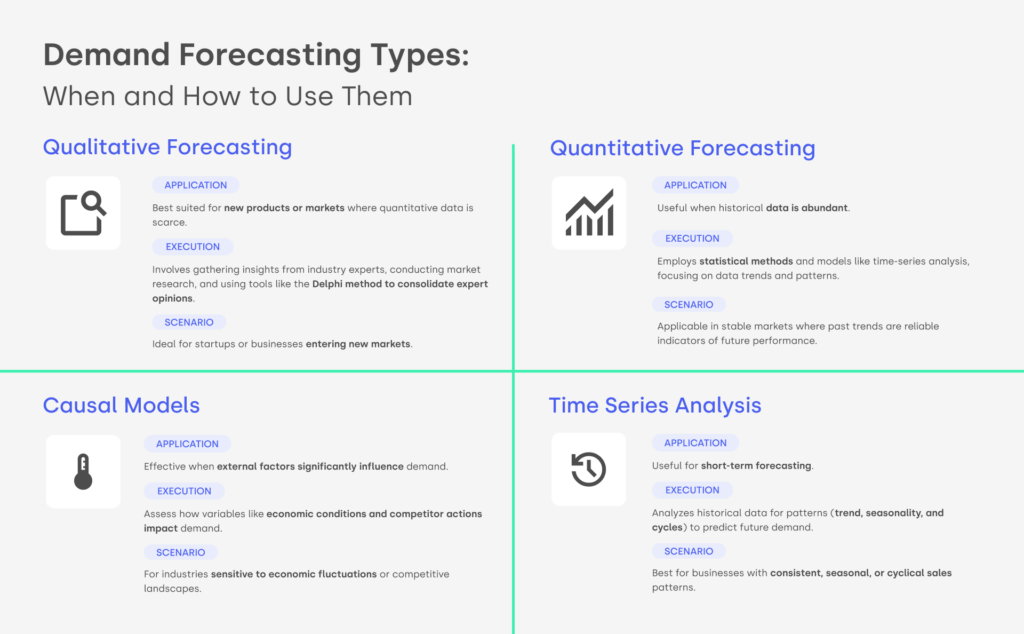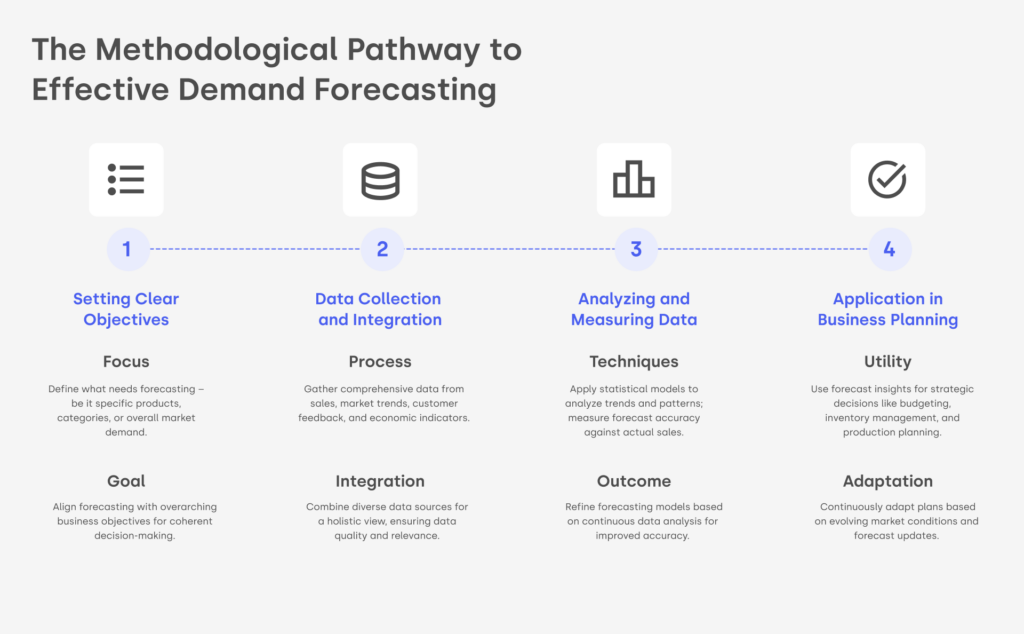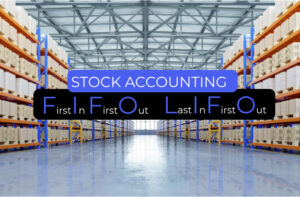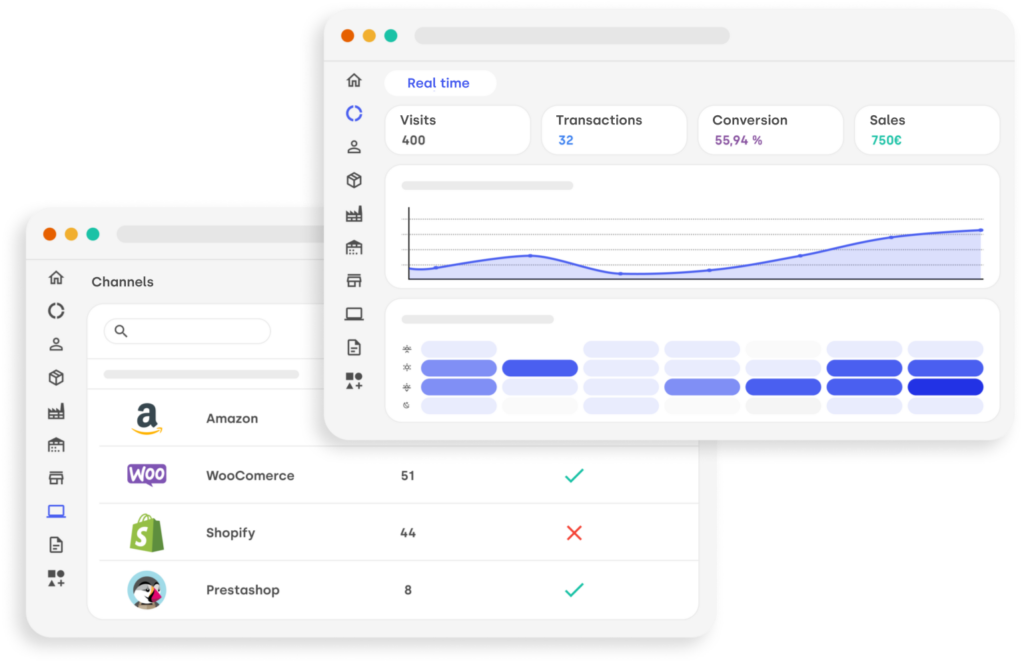Demand forecasting stands as a cornerstone in both traditional and ecommerce businesses, shaping strategies for inventory management, production planning, and overall market responsiveness. This extensive guide dives deep into the mechanics, methodologies, and applications of demand forecasting, providing an enriched perspective that assimilates and surpasses the insights from various sources.
Unraveling the Complexities of Demand Forecasting
Demand forecasting is a sophisticated process that blends predictive analytics, market analysis, and statistical modeling to anticipate future customer demands. Integral to demand planning, this process is critical for aligning business operations with market dynamics, ensuring efficiency, and optimizing resource allocation.
Dissecting Demand Forecasting Types: When and How to Use Them
Demand forecasting can be segmented into several types, each addressing different business needs and scenarios:

Qualitative Forecasting:
- Application: Best suited for new products or markets where quantitative data is scarce.
- Execution: Involves gathering insights from industry experts, conducting market research, and using tools like the Delphi method to consolidate expert opinions.
- Scenario: Ideal for startups, businesses entering new markets or launching new products
Quantitative Forecasting:
- Application: Useful when historical data is abundant.
- Execution: Employs statistical methods focusing on data trends and patterns.
- Scenario: Applicable in stable markets where past trends are reliable indicators of future performance.
Causal Models:
- Application: Effective in dynamic markets where external factors significantly influence demand.
- Execution: Incorporates econometric models and regression analysis to assess how variables like economic conditions and competitor actions impact demand.
- Scenario: Ideal for industries sensitive to economic fluctuations or competitive landscapes.
Time Series Analysis:
- Application: Useful for short-term forecasting.
- Execution: Analyzes historical data for patterns (trend, seasonality, and cycles) to predict future demand.
- Scenario: Best for businesses with consistent, seasonal, or cyclical sales patterns.
Exploring Key Methodologies in Demand Forecasting
Demand forecasting encompasses various methodologies, each offering unique insights and catering to different business needs. Understanding these methodologies is crucial for businesses to accurately predict market demand and make informed decisions. Here, we explore five pivotal demand forecasting methodologies: trend projection, market research, sales force composite, the Delphi method, and the econometric method.
Trend Projection Method
- Overview: Trend projection, a quantitative approach, involves analyzing historical sales data to identify patterns and project these trends into the future.
- Application: This method is particularly effective in stable markets where past patterns are likely to continue.
- Process: It involves statistical techniques like moving averages or exponential smoothing, which smooth out anomalies in past data to reveal underlying trends.
- Ideal Use Case: Best for products or services with consistent sales patterns over time.
Market Research Method
- Overview: Market research is a qualitative approach that gathers data directly from potential or current customers through surveys, interviews, and focus groups.
- Application: It helps in understanding customer preferences, behaviors, and potential market changes.
- Process: The collected data is analyzed to identify customer needs, gauge market potential, and predict future demand.
- Ideal Use Case: Particularly useful for new product launches or when entering new markets.
Sales Force Composite Method
- Overview: This method involves collecting insights and predictions from the sales team, who are often closest to the customers and market trends.
- Application: Sales representatives provide their sales forecasts, which are then aggregated to form a company-wide forecast.
- Process: It leverages the on-ground experience and customer knowledge of the sales team, making the forecast more grounded in market realities.
- Ideal Use Case: Effective in businesses where the sales team has a strong understanding of customer needs and market conditions.
Delphi Method
- Overview: The Delphi method is a structured communication approach that relies on a panel of experts.
- Application: Experts answer questionnaires in multiple rounds, and after each round, a facilitator provides a summary of the forecasts and the reasons behind them.
- Process: The process continues until the panel reaches a consensus, ensuring diverse opinions are considered and refined.
- Ideal Use Case: Useful in scenarios involving significant uncertainty or where expert opinion is highly valued.
Econometric Method
- Overview: The econometric method is a quantitative approach that uses statistical models to forecast demand, considering multiple economic variables.
- Application: It involves building models that correlate demand with factors like price, income levels, economic conditions, and other relevant variables.
- Process: Utilizes regression analysis and other statistical techniques to understand how changes in economic factors affect demand.
- Ideal Use Case: Best suited for scenarios where demand is heavily influenced by economic factors and external market conditions.
The Methodological Pathway to Effective Demand Forecasting
Implementing a successful demand forecasting strategy involves a systematic approach:

Setting Clear Objectives:
- Focus: Define what needs forecasting – be it specific products, categories, or overall market demand.
- Goal: Align forecasting with overarching business objectives for coherent decision-making.
Data Collection and Integration:
- Process: Gather comprehensive data from sales, market trends, customer feedback, and economic indicators.
- Integration: Combine diverse data sources for a holistic view, ensuring data quality and relevance.
Analyzing and Measuring Data:
- Techniques: Apply statistical models to analyze trends and patterns; measure forecast accuracy against actual sales.
- Outcome: Refine forecasting models based on continuous data analysis for improved accuracy.
Application in Business Planning:
- Utility: Use forecast insights for strategic decisions like budgeting, inventory management, and production planning.
- Adaptation: Continuously adapt plans based on evolving market conditions and forecast updates.
Harnessing Technology for Refined Forecasting
Advancements in technology, particularly in demand planning software, have revolutionized demand forecasting. These tools offer AI-driven insights, predictive modeling, and data analytics capabilities, providing businesses with nuanced and precise demand predictions.
Softwares like Stockagile are the perfect choice for retail businesses.
The Future Trajectory of Demand Forecasting in Commerce
The future of demand forecasting promises further advancements in technology and methodology, offering businesses enhanced opportunities for optimization and growth.
Demand forecasting is a strategic imperative in modern commerce. Effective implementation can lead to optimized operations, cost reductions, and elevated customer satisfaction, providing businesses with a significant competitive edge.
Demand Forecasting FAQs
The choice depends on market dynamics, availability of data, industry-specific factors, and the nature of products or services.
While the foundational principles remain similar, ecommerce often demands more real-time data integration and rapid adaptability due to the fast-paced nature of online markets.
Yes, small businesses can leverage simpler models and technologies for demand forecasting to enhance their decision-making and operational efficiency.
Technologies like AI and machine learning provide deeper market insights, improve forecast accuracy, and enable real-time data analysis.
Regular revision is crucial to adapt to market changes, with the frequency depending on the industry’s dynamism and data availability.








